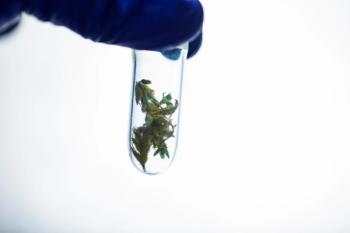
Cannabis Science and Technology
- November/December 2024
- Volume 7
- Issue 6
- Pages: 19-23
Expanding the Panel of Heavy Metals in Cannabis Consumer Products Beyond the Big Four: Understanding the Cost Difference

Robert Thomas investigates the costs that go into heavy metal testing through an informative exercise that debunks claims that a larger panel would significantly increase costs.
Given the number of potential sources of elemental contaminants throughout the production of cannabis consumer products, there is a compelling argument to be made for expanding the required testing of heavy metals beyond the "big four" required by most states. While the cost of expanding the panel is a concern, Robert Thomas breaks down the cost of running an ICP-MS system in an effort to dispel these concerns and encourage adoption of the higher standard. This article has been adapted from the author’s book, entitled Measuring Heavy Metal Contaminants in Cannabis and Hemp (1).
In last month’s “Navigating the Lab” column, I suggested that the fractured nature of state-based heavy metal regulations for cannabis and hemp products was likely compromising consumer safety (2,3). I presented compelling evidence that the industry did not have a good understanding of sources of elemental contaminants in the cultivation and manufacturing process and as a result the panel should be expanded beyond the big four heavy metals. I have received a lot of positive feedback about my article, but as expected there has been some push-back and although the data cannot be disputed there has been some concern about the increased cost of expanding the list, even though it is well-recognized that inductively coupled plasma mass spectrometry (ICP-MS), the technique that is typically used to carry out the determinations, can quantify 95% of the periodic table in a few minutes.
Cannabis Testing Lab Requirements
It’s clear that more state regulators are beginning to show interest in monitoring additional elemental contaminants to ensure safer consumer products. This is especially the case for cannabis vaping devices, which are notorious for producing metal particles derived from the corrosion of components inside the device such as iron (Fe), chromium (Cr), nickel (Ni), and copper (Cu), which are not on the regulated panel for the vast majority of states. Although it might be considered an overreach to monitor the complete suite of 24 elemental impurities defined in USP and ICH pharmaceutical guidelines, at least 14 of them (Class 1, 2A and 3 elements - Pb, Cd, As, Hg, Co, V, Ni, Li, Sb, Ba, Mo, Cu, Sn, Cr) are required in all oral, inhalation and transdermal drug products (4). But how many metals should there be in an expanded cannabis panel? The majority of the 39 states that have legalized medical cannabis require the big four — lead (Pb), cadmium (Cd), arsenic (As) and mercury (Hg) — to be tested. New York State also requires the additional testing of Cr, Ni, Cu, and antimony (Sb), while Michigan also adds Cr, Ni, and Cu, and Maryland (along with a few other states) includes Cr in addition to the big four (5).
How Many Metals are Enough?
The National Institute of Standards and Technology (NIST) has developed a 13-toxic element hemp standard reference material (SRM) through its CannaQAP Program to include Pb, Cd, As, Hg, beryllium (Be), cobalt (Co), Cr, manganese (Mn), molybdenum (Mo), Ni, selenium (Se), uranium (U), and vanadium (V) (6, 7). In addition, AOAC and ASTM standards organizations have written ICP-MS standardized methodologies for 12 (Pb, Cd, As, Hg, Sb, Ba, Cr, Cu, Ni, Ag, Se, Zn) and 23 (Pb, Cd, As, Hg, Cr, Cu, Zn, Se, Ag, Sb, Ba, Na, Al, K, Mn, Fe, Co, Ni, Mo, Tl, Th, V, U) elemental contaminants respectively (8, 9). So even though the expanded number is open to debate, clearly it is significantly more than just the big four heavy metals.
Cost of Analysis
To get a better understanding of the cost difference between testing for four metals and an expanded panel of elemental contaminants, let us first take a closer look at what it costs to run an ICP-MS system (10). For the purpose of this evaluation, let us make the assumption that the major operating costs associated with running an ICP-MS are the gases, electricity, and consumable supplies. For comparison purposes, the exercise will be based on a typical cannabis testing laboratory running their instrument for two and half days (20 h) per week and 50 weeks a year (1,000 h per year). And to simplify the comparison, let’s take the expanded panel to be 16 elements (an average of all the elements mentioned earlier) (a).
These data are based on the average cost of gases, electricity, and instrument consumables in the United States (US) in 2024. It is very difficult to estimate average costs, but they have been obtained from a number of publicly available commercial sources, including suppliers of industrial and high-purity gases, independent utilities companies, a number of ICP-MS instrument vendors and sample introduction/consumable suppliers. I also surveyed several cannabis testing labs in the US to get a better understanding of regional differences. It’s also important to emphasize that these costs might also vary slightly based on geography and/or a particular vendors’ instrument being used with slightly different technology, features, and hardware.
Gases: A typical ICP-MS uses a total of approximately 17 L/min (~1,000 L/h) of gaseous argon (including plasma, nebulizer, and auxiliary flows). For this reason, most users install a Dewar vessel containing a liquid supply of argon (b). Liquid argon tanks come in a variety of different sizes, but a typical Dewar system used for ICP-MS holds about 240 L of liquid gas, which is equivalent to 6,300 ft3 (178,000 L) of gaseous argon. (Note: The Dewar vessel can be bought outright but are normally rented). It costs about $470 to fill a 240 L Dewar vessel with liquid argon (average of six different states). At a typical argon flow rate of 17 L/min total gas flow, a full vessel would last for almost 175 h (c). Again, assuming a typical laboratory runs their instrument for 1,000 h per year, this translates to six fills at approximately $470 each, which is equivalent to about $2,800 per year.
Another added expense with ICP-MS is if it is fitted with collision/reaction cell (CRC) or collision/reaction interface (CRI) technology, the cost of the collision or reaction gas will have to be added to the running costs of the instrument. Fortunately, for most CRC applications, the gas flow is usually less than 5 mL/min, but for the CRI approach, typical gas flows are 100–150 mL/min. The most common CRC gas used to measure the big four heavy metals in cannabis is helium, although hydrogen and/or other reactive gases might need to be used for the additional elements. The cost of high-purity helium is in the order of $400 for a 300 ft3 (8,500 L) cylinder, whereas a cylinder of hydrogen is approximately $300. One cylinder of either gas should be enough to last 1,000 hours at these kinds of flow rates. So, for this costing exercise, we will assume that the laboratory is running a CRC/CRI instrument using these two gases, with an additional expense of $700 on top of the $2,800 for liquid argon, which translates to a combined total of $3,500. However, if other or additional CRC gases are being used, these should be factored into the calculation.
Electricity: The main power requirement for an ICP-MS is the radio frequency (RF) generator. The average cost of electricity in the U.S. in 2024 is 15.45 cents per kWh (11). Based on the voltage, magnitude of the electric current, and the number of lines/phases used, the majority of modern instruments draw about 5 kW total power. This works out to be ~$770 for an instrument that’s run 1,000 hours per year (Note: Check the cost of electricity in your state/country).
Consumables: The main consumable supplies in ICP-MS are the plasma torch and the sample introduction components. The major consumable is the torch itself, which consists of two concentric quartz tubes and a sample injector either made of quartz or some ceramic material. In addition, a quartz bonnet normally protects the torch from the RF coil. There are many different demountable and semi demountable torch designs available, but they typically cost about $700 for a complete system. Depending on sample workload and matrices being analyzed, it is normal to go through a torch every six months. In addition to the torch, other parts that need to be replaced or at least to have spares include the nebulizer (~$800), spray chamber (~$700), and sample capillary, pump tubing and autosampler tubes ($300). When all these items are added together, the annual cost of sample introduction consumables for ICP-MS is on the order of $3,200.
In addition to the plasma torch and sample introduction supplies, ICP-MS requires consumables that are a part of the mass spectrometer. The first area is the interface region between the plasma and the mass spectrometer, which contains the sampler and skimmer cones (Note: some systems have three cones). These are traditionally made of nickel, which are recommended for most matrices, or platinum for highly corrosive samples and organic matrices. A pair of nickel cones costs $800–900, whereas a set of platinum cones costs around $4,000–5,000. Two sets of nickel cones and perhaps one set of platinum cones would be required per year. Other cone materials and tips are available, so whatever is used, just substitute the relevant cost. It is also worth pointing out that unless hydrofluoric acid (HF) is used in the sample digestion, platinum cones may not be required. If that is the case, just substitute an additional set of Ni cones. The other major consumable in ICP-MS is the detector, which has a lifetime of approximately one year, and costs about $3,000.
When all these are added together - the torch, sample introduction components, interface cones and detector, ICP-MS consumable supplies represent an average annual cost of ~$12,400 shown in Table I.
Therefore, the total annual running cost for an ICP-MS including gases, power, and consumable supplies being operated for 1,000 hours/year, is shown in Table II.
Cost per Sample
We can take the data given in Table II a step further and use these numbers to calculate the operating costs per individual sample, based on the two analytical scenarios of a laboratory determining four elements per sample and another measuring 16 elements per sample. First, let us take a closer look at the difference in analysis time.
Four Metals per Sample
Assuming an integration time of two seconds per element, this translates to ten seconds per replicate, including eight seconds actual measurement time plus an overhead time of approximately two seconds for scanning and settling the quadrupole. This equates to 20 seconds per duplicate analysis. When a sample uptake time of 30 seconds, stabilization time of 10 seconds, and a washout time of 30 seconds are factored in, this means a total analysis time of 90 seconds per duplicate (d).
16 Metals per Sample
Again, assuming an integration time of two seconds per element, this translates to 37 seconds per replicate including 32 seconds actual measurement time plus overhead time of approximately five seconds for scanning and settling the quadrupole. This equates to a measurement time of 74 seconds per duplicate. The sample uptake time of 30 seconds, stabilization time of 10 seconds and a washout time of 30 seconds will be exactly the same as for four elements. So, when this is added in, this translates to a total analysis time of 144 seconds per duplicate (e).
This comparison between four elements per sample and 16 elements per sample is shown in Table III.
It should also be emphasized, that a real-world scenario might also include a recalibration/reslope of the instrument, which is typically done every one to two hours depending on the sample loading and type. So, this would have to be factored into the calculation if this additional step is being carried out.
From this, the cost per sample can be calculated from the annual operating costs. This calculation is shown in Table IV and summarized in Table V.
Final Thoughts
It must be emphasized that these figures have been generated for a typical cannabis testing lab workload using the average cost of gases, power, and consumables in the US in 2024. However, if the costs in your region are different, or your analytical scenario, sample loading, measurement/integration times, recalibration frequency, and use of a rapid sampling system, for example, are different, just plug your numbers into the calculation (a simple spreadsheet would be useful). Even though the final operating costs per sample might be different, the comparative costs should be the same. So, expanding the analyte panel from four to 16 elemental contaminants represents a 400% increase in the number of elements, the corresponding cost increase is only 60% per sample.
This is an important point to emphasize because many cannabis testing labs are running “lean operations” and are very concerned that measuring the additional elements might be cost prohibitive. This costing exercise has clearly indicated that this is not the case. It is difficult to know what the final panel of elements will be whenever there is federal oversight of the cannabis industry, but based on the 20-plus years of carrying out a risk analysis of the pharmaceutical industry, regulators eventually ended up with a list of 24 elemental impurities permitted daily exposure limits (PDEs) in drug products and substances by drug delivery method. I am not sure the cannabis industry needs this many, but it would definitely benefit from carrying out a risk assessment of all the potential sources of elemental contaminants during the entire cannabis production and manufacturing process (12). Particularly as an estimated 65 million people use cannabis in the US with vaping increasing every year as the preferred delivery method (13). The number of metals might not need to be as many as 16, but clearly it should be significantly more than just the big four to ensure the safety of all cannabis consumer products.
Footnotes
a. This comparison will not include the cost of sample preparation. Clearly there are consumables, vessels, reagents and acids involved with digesting cannabis-based samples, and it would be valid to include them but that is going to be the same for all analytical scenarios. So, for this exercise, only the cost of running the instrument will be included in the calculations.
b. When liquid argon is stored in a Dewar vessel, there is a natural bleed-off to the atmosphere when the gas reaches a certain pressure. For this reason, a bank of argon cylinders is probably the best option for laboratories that do not use their instruments on a regular basis. A cylinder of argon costs approximately $150 for 340 ft3 (9,630L), so at 17 L/min, a cylinder would last about 10 hours. So, the overall cost of argon would depend on the number of cylinders purchased.
c. Some ICP-MS instrumentation also use low-flow torches, which operate at approximately 30% lower argon consumption compared to other instruments. So, this should be taken into consideration if this type of technology is being used.
d. Use of an intelligent autosampler, with switching valves and rapid sampling capabilities, can reduce sample uptake and washout times by about 50% on average, so they need to be factored into the calculation if being used.
e. If different measurement times are being used for specific elements or triplicate analysis per sample is being carried out, the total analysis time needs to be recalculated.
References
- Thomas, R. J. Measuring Heavy Metal Contaminants in Cannabis and Hemp; CRC Press, 2020,
https://www.routledge.com/Measuring-Heavy-Metal-Contaminants-in-Cannabis-and-Hemp/Thomas/p/book/9780367417376 - Thomas, R. Understanding Sources of Heavy Metals in Cannabis and Hemp Consumer Products, Part I: Is the Fractured Nature of State-based Regulations Ignoring the Evidence?, Cannabis Science and Technology, 2024, 7(3), 18-22.
- Thomas, R. Understanding Sources of Heavy Metals in Cannabis and Hemp Consumer Products, Part II: Is the Fractured Nature of State-based Regulations Ignoring the Evidence?, Cannabis Science and Technology, 2024, 7(4), 22-29.
- Pruyn, S.A.; Wang, Q.; Wu, C.G.; and Taylor, C.L.; Quality Standards in State Programs Permitting Cannabis for Medical Uses, Cannabis and Cannabinoid Research, 2022, 7(6).DOI: 10.1089/can.2021.0164
- Thomas, R.J., The Importance of Measuring Heavy Metal Contaminants in Cannabis and Hemp, Analytical Cannabis, 2021,
http://www.scientificsolutions1.com/the-importance-of-measuring-heavy-metal-contaminants-in-cannabis-and-hemp-312957.pdf - Barber, C.A.; Bryan-Sallee, C.E.; Burdette, C.Q.; Kotoski, S P.; Phillips, M.M.; Wilson, W.B.; Wood, L.J.; Cannabis Laboratory Quality Assurance Program: Exercise 2 - Toxic Elements, NIST Final Internal Report (NIST IR 8452), 2022,
https://nvlpubs.nist.gov/nistpubs/ir/2022/NIST.IR.8452.pdf. - NIST’s New Hemp Reference Material Will Help Ensure Accurate Cannabis Measurements, 2024,
https://www.nist.gov/news-events/news/2024/07/nists-new-hemp-reference-material-will-help-ensure-accurate-cannabis - Nelson, J.; Jones, C.; Heckle, S.;, Anderson, L.; Determination of Heavy Metals In A Variety of Cannabis and Cannabis-Derived Products, First Action, Journal of AOAC INTERNATIONAL, 2002, 105(6), 1640-1651, DOI: 10.1093/jaoacint/qsab173.
- ASTM D8469-22: Standard Test Method for Analysis of Multiple Elements in Cannabis Matrices by Inductively Coupled Plasma Mass Spectrometry (ICP-MS), ASTM D37 Standards Committee, 2022,
https://www.astm.org/d8469-22.html - Thomas, R.J., Measuring Heavy Metal Contaminants in Cannabis and Hemp, ISBN 9780367417376, CRC Press, 2020, Chapter 29 – Do you know what it costs to run your AS instrument?,
https://www.routledge.com/Measuring-Heavy-Metal-Contaminants-in-Cannabis-and-Hemp/Thomas/p/book/9780367417376 - Simms, D., Electricity Rates by US States, USA Today, 2024,
https://www.usatoday.com/money/homefront/deregulated-energy/electricity-rates-by-state/ - Thomas, R.J.; Destefano, A; Understanding Sources of Heavy Metals in Cannabis and Hemp: Benefits of a Risk Assessment Strategy, Analytical Cannabis, 2022,
http://www.scientificsolutions1.com/understanding-sources-of-heavy-metals-in-cannabis-and-hemp-benefits-of-a-risk-assessment-strategy-314044.pdf - Baldwin, G.T.; Vivolo-Kantor, A.; Hoots, B.; Roehler, D.R.; Ko, J.Y.; Current Cannabis Use in the United States: Implications for Public Health Research, American Public Health Association, 2024,
https://ajph.aphapublications.org/doi/full/10.2105/AJPH.2024.307823
About the Guest Columnist
Robert (Rob) Thomas is the principal scientist at Scientific Solutions, a consulting company that serves the educational needs of the trace element user community. He has worked in the field of atomic and mass spectroscopy for almost 50 years, including 24 years for a manufacturer of atomic spectroscopic instrumentation. Rob has written over 100 technical publications, including a 15-part tutorial series entitled, A Beginner’s Guide to ICP-MS. He is also the editor and frequent contributor of the "Atomic Perspectives" column in Spectroscopy magazine, as well as serving on the editorial advisory board of Technology Networks. He recently accepted the position of Assistant Adjunct Professor of Chemistry at the University of North Dakota. In addition, Rob has authored six textbooks on the fundamental principles and applications of ICP-MS. His most recent book is entitled A Practical Guide to ICP-MS and Other AS Techniques, which was published in September 2023. Rob has an advanced degree in analytical chemistry from the University of Wales, UK, and is also a Fellow of the Royal Society of Chemistry (FRSC) and a Chartered Chemist (CChem).
How to Cite this Article
Thomas, R. Expanding the Panel of Heavy Metals in Cannabis Consumer Products Beyond the Big Four: Understanding the Cost Difference, Cannabis Science and Technology, 2024, 7(6), 19-23.
Articles in this issue
Newsletter
Unlock the latest breakthroughs in cannabis science—subscribe now to get expert insights, research, and industry updates delivered to your inbox.





